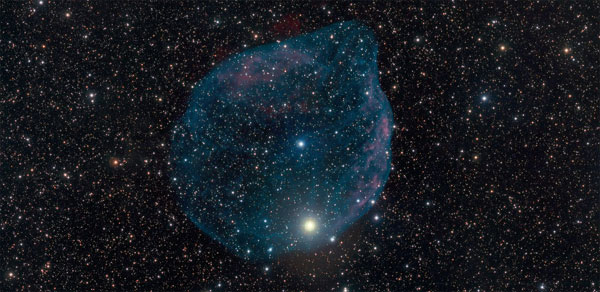
wolf-rayet shells

Sharpless 308 by Marco Lorenzi
Wolf-Rayet (WR) stars are massive stars above 20 solar masses which have left the main sequence and which will eventually go supernova. During this evolution away from the main sequence, the star expands beyond its Roche limit, such that its outer parts are blown away as a strong stellar wind. The remaining core of the massive star forms the actual WR star, being extremely hot with a temperature between 30000 and 120000 K. The WR star emits therefore most of its light in the ultraviolet range and does not need to be particularly bright in the visible range.
The spectral marker of a WR star is the presence of broad emission lines, which are due to the highly accelerated stellar winds, and usually the absence of hydrogen absorption bands. These stars were first discovered by Charles Wolf and Georges Rayet in the 1860ies and puzzling due to the emission bands in there otherwise continuous spectra.
|
image credit: www.threehillsobservatory.co.uk |
The spectrum of WR 135 in Cygnus taken by amateur astronomer Robin Leadbeater reveals the strong, broadened emission bands of the stellar wind superimposed to the continuous black body spectrum of the actual star. |
The stellar winds of WR stars may give rise to bubble-shaped nebula which have often very strong OIII emission lines, making them interesting targets for visual observers.
How are Wolf-Rayet ring nebula formed?
Gruendl and colleagues have suggested a relatively simple model for the different morphologies of WR ring nebula, which is based on prior work and the "three wind model" of Garcia-Segura and colleagues.
WR ring nebula are formed as a shock front caused by three stellar winds which were ejected by the stars at different times. During its main sequence life time, the WR precursor is a hot an massive star of spectral class O, which clears its immediate environment by strong radiation and creates a local bubble in the interstellar medium (first wind). This first rarefied wind has typical velocities of 103 km/s and mass loss rates of 10-6 to 10-7 solar masses per year.
When the star enters shell burning, it expands to a red super giant (RSG), leaving its outer layers only loosely bound to the star, such that they are eventually blown off as a "slow wind" or RSG wind, which is quite dense. Typical velocities of this RSG wind are 10-25 km/s and mass loss rates of 10-4 to 10-5 solar masses per year.
This stellar wind becomes faster as the star enters the WR stage. As this fast WR wind sweeps up the material of the slower RSG wind, a shock front is formed and hence a WR ring nebula. Typical velocities of the WR wind are again 103 km/s with mass loss rates of 10-4 to 10-5 solar masses per year. This WR ring nebula resides within the interstellar bubble created by the first wind in this three wind model. Eventually, the WR wind may break out of the slow RSG wind and expand then into this interstellar bubble.
Structure of Wolf-Rayet ring nebula
WR ring nebula show very different structures and morphologies. How do these different morphologies arise? Gruendl and colleagues suggested a relatively simple mechanism, which is mainly based on the fact that emission of HII and [OIII] are caused by different exctitational mechanisms. [OIII] emission is based on a transition, of which the upper, excited level in the oxygen ions is populated mainly by collisional excitation, while emission of HII is based on recombination of hydrogen ions (i.e. protons) with free electrons. While emission of [OIII] increases with increasing temperature, the line strength of HII decreases with increasing temperature, as recombination is inhibited.

As the fast WR wind sweeps up the slower RSG wind, a shock front is formed that is very hot at its front side, leading to the emission of mainly [OIII]. By radiative cooling, the temperature decreases in regions closer to the central WR star, such that these inner regions will emit HII radiation as well.
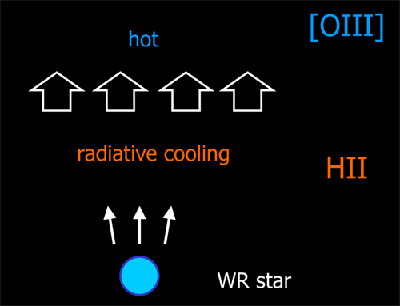
Radiative cooling is the more efficient the denser the medium of the shock front. In a high density medium the temperature decreases rapidly behind the shock front, such that regions of HII emission follow very closely the [OIII] front. As the medium is more tenuous, [OIII] and HII regions become spatially separated. For very tenuous media or for media with strong variations of the density, we can trace by the [OIII] emission the actual shock front and by the HII emission the denser inner areas of the medium. Variations in the density of the medium can therefore lead to "bulges" in the [OIII] shells, which are termed "break-out" structures. Break-out structures are easily discerned for instance in the Crescent Nebula or Sharpless 308.

In their paper, Gruendl et al. examine a series of WR ring nebula and try to resolve the different morphologies of these nebulas using [OIII] and H-alpha imaging. With their model, they try to explain the observed structural differences by a relatively simple mechanism.
Papers
Garcia-Segura and Mac Low (1995) Astrophysical Journal 455:145
Garcia-Segura and Mac Low (1995) Astrophysical Journal 455:160
Heckathorn et al. (1982) Astrophysical Journal 252:230
Chu, Treffers and Kwitter (1983) Astrophysical Journal S53:937
|
Download finder charts for the Wolf-Rayet nebula as pdf file |
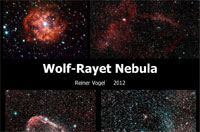 |
![]()
Observing Reports
|
EZ CMa (WR 6) and Sharpless 308 in Canis Major 06 54 13 -23 55 42
Starting point for the star hop to Sharpless 308 is o1 CMa. This star is embedded in the open cluster Collinder 121, which is unspectacular even in binoculars and does not really stand out as a cluster. Shifting o1 CMa into the middle of the field of view of the finder eyepiece, you will be surprised by the view when you switch to OIII filtering (most spectacular, of course, with a filter slide or wheel). The OIII filter shows you a ghostly crescent of glowing gas, that extends from o1 CMa first towards NW and then towards N as part of a huge bubble of 40' diameter. This bubble is not related to o1 CMa itself, but is the blown of outer shell of EZ CMA, the Wolf Rayet star WR 6, about 20' N of o1 CMa, in the middle of the bubble. With my 14" Dob, the western crescent is the brightest part and can be easily followed with OIII filter. Towards NW, the crescent becomes fainter. On the image to the right and other deep narrowband images by Don Goldman and Marco Lorenzi (see top of this page), one can see a "rupture" of the bubble and a decrease of the surface brightness. With my 22" Dob, I can follow the shell well beyond this area. At around 11 o'clock, there is another condensation where the shell becomes brighter before it slowly fades out in the eastern part. Under excellent conditions with perfect transparency down to the horizon, I could see the entire shell, including the eastern part, that closes the circle towards o1 CMa. With 7mm exit pupil, the shell appeared filled with an extremely faint OIII glow, which disappeared at smaller exit pupils.
|
|
|
WR 7 and Thor's Helmet NGC 2359 in Canis Major 07 18 29 -13 13 02
This is a bright, very distinct, and highly structured nebula, responding again extremely well to OIII filtering.
The central bubble of the WR shell appears structured. A bright bar extends from S of the bubble towards WSW. There are several fainter, but still distinct extensions towards NW and NE.
|
|
|
WR 102 and G2.4 +1.4 in Sagittarius 17 45 48 -26 10 27
This WR shell is in a very dense star field in Sagittarius.
Not yet observed.
image by José Joaquin Pérez |
|
|
WR 124 (Merrill's Star) and Sharpless 80/M1-67 in Sagitta 19 11 31 +16 51 38
Sharpless 80 aka Minkowski 1-67 is an extremely faint shell around WR 124. Unlike most other WR shells, Sharpless 80 has hardly any OIII emission, but mostly NII and, a little less, HII.
My observing notes with my 22" Dob: 08/2008: unsuccessful 06/2010: suspected as a faint glow around WR star with H beta filter 10/2010: at 350x and with H beta filter, a diffuse glow was observed around the WR star. 08/2012: under excellent conditions, at 200 and 350x visible already without filter as an extremely faint shell. There is a small contrast gain with H beta filter. |
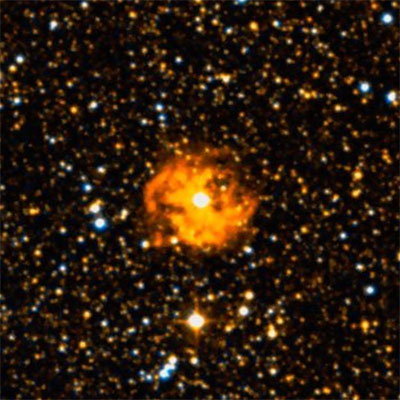
|
|
WR 128 shell in Sagitta 19 48 32 +18 12 04
This is an extremely faint WR shell in Sagitta, close to Sharpless 84 (parts of it visible in the upper left corner of the DSS image). During two observing sessions with my 22" f/4.5 Dob and the 13mm Nagler with OIII filter, a segment in the NE part of the shell was suspected as an extremely faint filament. This corresponds to the brightest part of the shell in the OIII image by Gruendl. Lionel Mulato was the first to take an excellent narrow band image of this WR nebula suggesting a quite elongated shell structure.
|
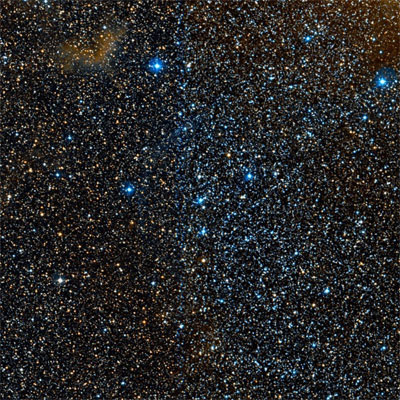
|
|
WR 134 shell in Cygnus 20 10 14 +36 10 35
This Wolf-Rayet bubble is not listed in any catalog, despite it is well visible on the DSS. When I observed this shell for the first time during spring of 2009, I knew of only a single prior observation by Matthias Kronberger. My interest in this shell was stimulated by a narrow band image by JP Metsävainio. The WR shell is visible in the right part of this mosaic as a distinctly blue OIII crescent, using the Hubble palette version. The shell is roughly half ways between the Tulip Nebula, Sharpless 101, and the Crescent Nebula, NGC 6888. With my 22" Dob, the WR shell is not or only hardly visible without filter and reacts extremely well to the OIII filter. With filter it appears as a crescent of roughly 15', opened towards east. Its appearance and brightness is similar to that of another WR shell Sharpless 308 in Canis Major, which is, however, considerably larger. This shell is not difficult at all and is also faintly visible with my 8" Dob and OIII filter from my suburban backyard. The association of the shell with WR 134 is not certain, despite that WR 134 (the middle star in the distinct row of three stars) is in the center of the bubble. Instead WR 135, another mag 8 WR star about 15' east of WR 134 was suspected to be the true origin of the shell. This would agree as well with the further OIII emission on the image linked above. Other fantastic images of this shell were taken by Don Goldman and Travis Rector.
|
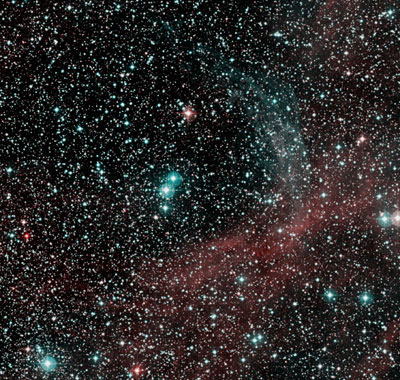 DSS narrowband image by Lionel Mulato, mouseover: OIII
|
|
WR 136 and the Crescent Nebula NGC 6888 in Cygnus 20 12 07 +38 21 18 7.7846 The Crescent Nebula is a relatively bright nebula and responds extremely well to the OIII filter. It is faintly visible even with 10x50 binoculars equipped with OIII filters. With a large telescope it is faintly visible without filter. With OIII filter it is a bright object with a distinct crescent shaped shock front towards NW and a lesser defined edge towards SE. Along the NW shock front there are brighter segments, in particular N of the mag 7.5 WR central star. The inside of the nebula is filled with faint filaments. A somewhat brighter filament extends from the WR star towards SE and other brighter filaments are in the SW part of the shell. The WR shell shows a break-out structure of the WR bubble into the interstellar bubble towards WNW, leading to a protrusion of the WR shell that is visible in OIII images only. This protrusion is faintly visible at the eyepiece and extends towards a mag 8.0 field star.
|
Crescent Nebel in OIII and HII (mouseover) by Dean Salman |
|
WR 157 and Sharpless 157 in Cassiopeia/Cepheus 23 15 12 +60 27 02
Sharpless 157 is not far from the Bubble Nebula in an area of the Cassiopeia/Cepheus border with many other emission nebula. With OIII filter, the main filament forms a large and visually obvious milky streak that is surrounded by other fainter filaments.
My observing notes (together with the annotated image to the right): 08/2005: A very long and relatively bright filament oriented NS is easily visible that responds extremely well to OIII filtering. S157a (bright knot in northern central part) best with H beta 11/2011: Main filament N/S oriented is most distinct (OIII). Faint patch E of it (OIII). Another shorter and weaker filament W of main filament (OIII). S part diffuse (H beta > OIII), consisting of two patches of which the E patch contains 157a (H beta > OIII). |
narrowband image by Dean Salman OIIII and HII channel (mouseover) of the above image
|
![]()
"Atypical" or uncertain Wolf-Rayet nebula
"Atypical" means here that the Nebula around the WR star is presumably not formed by the stellar wind of the WR star and hence not a classical Wolf-Rayet ring nebula. Instead, the nebula is more likely a classical (in part highly excited) HII region that is ionized by the UV radiation of the central star. For another one, the Bubble Nebula, the classification of the central star as a WR star is not clear.
|
WR93 and NGC 6357/Sharpless 11 in Scorpius 17 25 09 -34 11 12
This is a WR star in the War and Peace
Nebula NGC 6357, which makes it just above the horizon at our
latitudes
Observing notes with 16" f/4.5 Only the central part of this large HII region could be observed. With OIII, this part is relatively bright and appears not homogeneous, but distinctly mottled
|
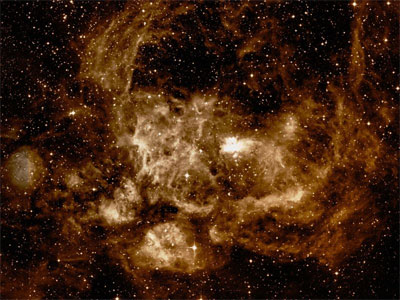
|
|
WR127 and Sharpless 92 in Vulpecula 19 46 16 +28 16 19
WR 127 is the ionizing star of the Sharpless 92, an extremely faint HII region. My observing notes with 22" f/4.5: Observed with 32mm, UHC better than H beta. Extremely faint glow, dark side towards SW. Difficult to distinguish from the star field with filter.
|
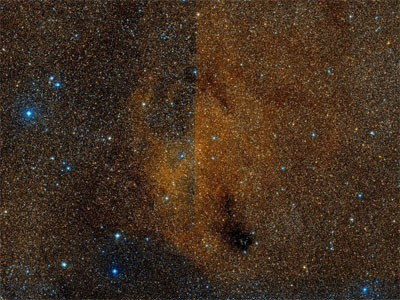
|
|
WR152/WR153 and Sharpless 132 in Cepheus 22 16 24 +55 37 37 WR152 22 18 46 +56 07 34 WR153 7.7846 Sharpless 132 is a fairly bright HII region in Cepheus. WR 153 is at the center of the actual Sharpless nebula. WR 152 is a bit offset in the center of a high ionization region emitting mainly in OIII and hardly visible in the DSS image. It is marked in the lower, inverted image. These are not typical WR shells created by the stellar winds of the progenitor stars, but rather molecular clouds ionized by the UV radiation of the WR and nearby O stars.
Observing notes with my 22" f/4.5 Dob: Observed several times with OIII filter, very large faint nebula, with a round dark structure to the E. There is a very large (40') extension to the SW, that is hardly visible on the DSS image, but quite distinct at the eyepiece with OIII filter. This area increases the size of the nebula to around 1.5°. |
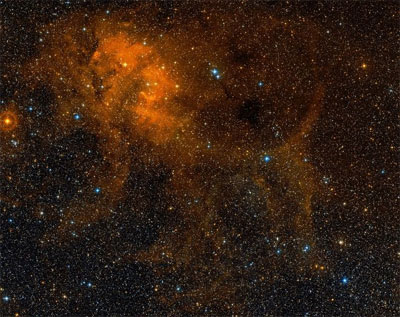
|
|
NGC 7635, the Bubble Nebula in Cassiopeia 23 20 48.3 +61 12 06
The information about the exciting star of NGC 7635 are ambiguous. Though often identified with a WR star, some reports list the central star as a "normal" O star and not (not yet?) a WR star. The Bubble nebula is more difficult than it would appear from its many images. The area involves some faint nebulosity with the bubble being in its brightest part. The bubble starts at a relatively bright, small and wedge-shaped area and can be followed visually over about 90 degrees from N to E (with OIII filter).
|
|
![]()
Some Wolf-Rayet shells of the Southern Skies
image credit: DSS
![]()